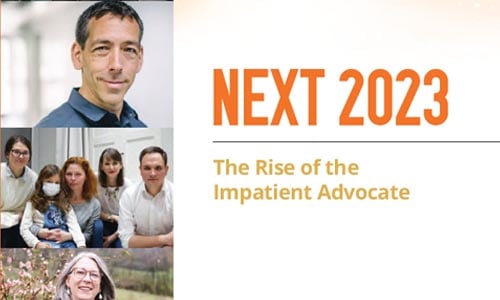Seize the Data: Ryan Colburn on Accelerating Pompe Disease Diagnoses — The 2023 NEXT Report
June 9, 2023
 Ryan Colburn has gone from engineering race cars and rockets to engineering research to diagnose Pompe disease earlier. Read an excerpt from the 2023 NEXT Report about Coburn’s efforts:
Ryan Colburn has gone from engineering race cars and rockets to engineering research to diagnose Pompe disease earlier. Read an excerpt from the 2023 NEXT Report about Coburn’s efforts:
In 2015, Colburn was diagnosed at the age of 31 with late onset Pompe disease, a lysosomal storage disorder in which an enzyme deficiency results in an accumulation of a complex sugar in the cells of the body and causes damage to muscles, the heart, and other organs.
Pompe disease was first identified in 1932 and the first treatment for the condition, an enzyme replacement therapy, won U.S. Food and Drug Administration approval in 2006. In the world of rare diseases, it’s got the benefit of being well characterized, a well-established patient community, and available therapies with more in development.
What Colburn started to take apart and tinker with a few years ago wasn’t a Formula 1 brake assembly, but the incidence rate for Pompe disease. He grew frustrated when he realized that the widely used incidence rate of 1 in 40,000 for Pompe disease was based on two small studies more than 20 years old that didn’t factor in all that had been learned since that time. Even though there was significantly more data to analyze, nobody had made any real effort to develop a more accurate figure. And that, he said, has consequences.
“Being more common than that is an attractive thing for creating business cases, for increased study, and basic understanding that can impact the way that we do development,” he said. “I was 31 when I was diagnosed but had symptoms since childhood and maybe birth, and I wasn’t alone. How many other people out there are undiagnosed but could benefit from being on treatment? How much could the overall rate at which we are developing knowledge benefit from giving those additional people an opportunity to participate?”
The NEXT report provides an overview of developments across the rare disease landscape and highlights trends in research, diagnosis, development, and treatment, as well as the changing regulatory and financial environment. Read about:
- How new genome sequencing technologies are cutting the cost and accelerating the speed of making a diagnosis
- How patients are taking a hands-on approach to research to change the fundamental understanding of some rare diseases
- What advances were made on the policy front in rare disease and the unfinished work that will be addressed in the coming year

Stay Connected
Sign up for updates straight to your inbox.
